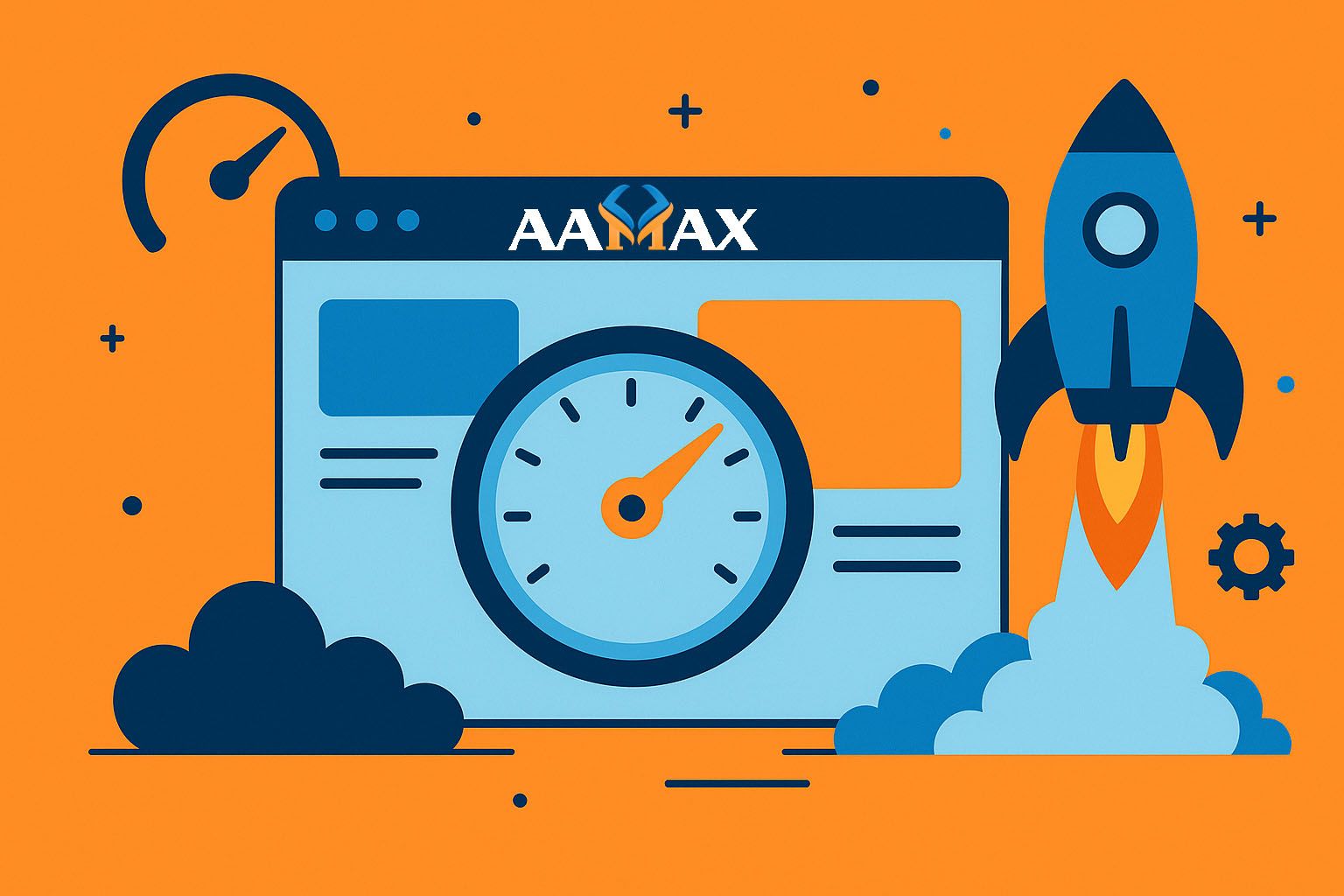
20+ Site Speed Statistics To Boost Your Loading Times
Website loading speed is more than just a user convenience—it’s a business necessity. In the digital world, every second counts. Site speed affects user experience, search engine rankings, and ultimately, your bottom line.
This article dives into 20+ eye-opening site speed statistics that underline the importance of fast-loading websites. You’ll also find insights and practical strategies to improve your site's performance.
Whether you're a developer, marketer, or business owner, these stats will help guide your optimization efforts. And when you need expert help, hire AAMAX — a full-service digital marketing company offering top-tier Web Development, Digital Marketing, and SEO Services.
🚀 Why Site Speed Matters More Than Ever
Before we jump into the numbers, here’s a quick look at why site speed is critical:
- User Experience: Slow websites lead to high bounce rates.
- SEO: Page speed is a confirmed ranking factor in Google's algorithm.
- Conversions: Faster sites mean more conversions and higher sales.
- Mobile-First Era: With mobile users dominating, performance is non-negotiable.
Let’s back this up with real data.
📊 20+ Site Speed Statistics That Demand Your Attention
1. 53% of mobile users abandon sites that take longer than 3 seconds to load
According to Google, more than half of mobile visitors will leave your site if it takes longer than three seconds to load.
2. 1-second delay reduces conversions by 7%
A famous stat from Akamai and other studies shows that every additional second in page load time can reduce conversions significantly.
3. Amazon could lose $1.6 billion annually with a 1-second slowdown
This shows the financial weight of performance. For large-scale websites, speed equals money.
4. 79% of online shoppers won’t return to a site with poor performance
Speed not only affects the current visit but future engagement too.
5. Google uses page speed as a mobile ranking factor
Google's “Speed Update” made speed a key part of its mobile search algorithm.
6. Pages loading in 2 seconds have an average bounce rate of 9%
Compare this with 38% bounce rate for pages that load in 5 seconds. Faster truly is better.
7. 47% of consumers expect a webpage to load in 2 seconds or less
Consumer expectations are high, and failing to meet them costs you visitors.
8. 94% of first impressions are design-related—speed is part of it
A fast-loading page enhances perceived design quality and professionalism.
9. The average mobile webpage takes 15 seconds to load
Despite best practices, most websites are underperforming on mobile.
10. Mobile pages that load in under 5 seconds see 70% longer sessions
Speed doesn’t just keep users on your page—it makes them stay longer and engage more.
11. Website speed impacts up to 20% of Google Ads Quality Score
If you’re running PPC ads, your landing page speed is directly affecting your ad costs.
12. A 0.1-second improvement can increase conversion rates by 8%
This micro-optimization can lead to macro results, as per Deloitte research.
13. Fast sites increase page views by 25%
Better performance encourages users to explore more of your site.
14. Bounce rate increases by 32% as page load time increases from 1 to 3 seconds
Users are impatient. Just a 2-second delay can cause a third of your audience to vanish.
15. Nearly 70% of consumers say page speed impacts their willingness to buy
If your eCommerce site is slow, you're potentially losing the majority of your buyers.
16. Google aims for sub-2-second load times
That’s their own benchmark—aspire to meet or beat it.
17. 53% of desktop users abandon pages taking longer than 3 seconds
It’s not just mobile—desktop users are equally impatient.
18. Sites that load in 1 second have 3x higher conversion rates
This is why Amazon, Walmart, and other top brands invest heavily in speed.
19. Users form an opinion of your site in 50 milliseconds
You barely get a chance to impress, so make sure speed is part of that first impression.
20. Retail pages that load in 6 seconds see 50% less engagement
Even a few seconds can drastically change the user interaction curve.
21. 85% of users expect mobile pages to load as fast or faster than desktop
Expectations have shifted. Mobile is no longer the slower fallback option.
🛠️ Top Tools to Measure and Optimize Site Speed
Knowing the importance of site speed is one thing—acting on it is another. Here are popular tools to help measure and improve your site’s performance:
- Google PageSpeed Insights
- GTmetrix
- Pingdom Tools
- Lighthouse (Chrome DevTools)
- WebPageTest
Each tool offers a detailed breakdown and recommendations for enhancements like image compression, code minification, lazy loading, and more.
💡 Best Practices to Improve Site Speed
These actionable tips can improve your site's loading times dramatically:
1. Compress and Optimize Images
Images account for a significant portion of page weight. Use next-gen formats like WebP and apply compression.
2. Minify CSS, JS, and HTML
Remove unnecessary characters and spaces to reduce file size.
3. Leverage Browser Caching
Save files locally in the user's browser for faster repeat visits.
4. Use a Content Delivery Network (CDN)
Distribute content globally to reduce latency.
5. Enable GZIP Compression
Compress files before sending them to the browser.
6. Reduce HTTP Requests
Simplify your design and minimize plugins or third-party scripts.
7. Use Lazy Loading for Images and Videos
Load only what’s needed when it’s needed to prevent bloating the page on first load.
8. Choose a Fast Web Host
Hosting has a major impact. Opt for VPS or cloud hosting over shared environments.
📱 Mobile Optimization: A Speed Priority
With Google’s mobile-first indexing, optimizing mobile speed is a must. Here’s what to focus on:
- Responsive design (avoid separate mobile URLs)
- Mobile-friendly font sizes
- Touch-friendly buttons
- Eliminate intrusive interstitials
- Lightweight themes
Slow mobile experiences kill conversion. Invest in responsive frameworks and test extensively across devices.
🔧 Technical SEO and Speed Go Hand-in-Hand
Site speed is deeply tied to technical SEO. Slow-loading pages:
- Reduce crawl efficiency
- Increase bounce rates
- Lower dwell time
- Decrease indexation of pages
A faster website improves both user engagement and SEO metrics like time on site and pages per session.
💼 Need Help Improving Site Speed? Hire AAMAX
If all this sounds overwhelming or you're looking for a partner to implement speed optimization strategies, hire AAMAX.
AAMAX is a full-service digital marketing agency offering:
- ✅ Web Development with performance-first design
- ✅ SEO Services that include Core Web Vitals optimization
- ✅ Digital Marketing to turn traffic into conversions
With years of experience and a proven portfolio, AAMAX can help you build a faster, smarter, and more profitable website.
🧠 Final Thoughts: Fast Sites Win More
Speed is a silent killer—or a secret weapon. If your website loads fast, you're already ahead of much of the competition.
Here’s a quick recap:
- Users expect pages to load in 2 seconds or less
- Slow websites hurt SEO, conversions, and revenue
- Optimizing speed leads to better engagement and trust
- Tools and best practices can help—but expert help accelerates results
Don’t wait. Every millisecond matters in the battle for attention and conversions online. Let AAMAX guide your digital journey with performance-driven web development and SEO.
Want to build a lightning-fast, conversion-ready website?
Hire AAMAX today — Your digital success partner.







